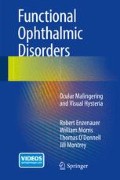Abstract
Decreased visual acuity is the most common complaint in functional ophthalmic problems. Although some tests for physiologic reflexes such as optokinetic nystagmus or preferential looking can be helpful, most tests depend upon the persuasion or tricking of the patient so that they are using the bad eye when the patient believes he is using only his good eye as he cooperates with the test. The techniques include refractive dexterity with down up refraction, sham lenses, neutralizing cylinders, and character counting on visual acuity charts. There is an occasional role for visual evoked potential / response, electroencephalogram, electroretinogram, potential acuity meter testing or acuity testing with the laser interferometer.
Access this chapter
Tax calculation will be finalised at checkout
Purchases are for personal use only
References
Alio JL, Artola A, Ruiz-Moreno JM, Ismail MM, & Ayala MJ (1993). Accuracy of the potential acuity meter in predicting the visual outcome in cases of cataract associated with macular degeneration. European Journal of Ophthalmology, 3, 189–92
Baudry S (1900) Simulated blindness. In: Norris WF, Oliver CA (eds) System of diseases of the eye by American, British, Dutch, French, German, and Spanish authors, vol IV. J.B. Lippincott Company, Philadelphia and London, pp 861–905
Beaumont WM (1918) Chapter XIX Malingering in relation to sight. In: Jones AB, Llewellyn LJ (eds) Malingering or the simulation of disease. P. Blakiston Son & Co., Philadelphia, PA, pp 324–415
Binks PG, Gouvier WD, Waters WF (1997) Malingering detection with the dot counting test. Archives of Clinical Neuropsychology 12(1):41–46
Cogan DG (1956) Chapter X. Nystagmus. In: Cogan DG (ed) Neurology of the ocular muscles. Charles C Thomas, Springfield, IL, pp 184–229
Creel, D. J. (Moran E. C. / U. of U. (n.d.). Visually Evoked Potentials. Webvision: The Organization of the Retina and Visual System. Retrieved March 25, 2014, from http://webvision.med.utah.edu/book/electrophysiology/visually-evoked-potentials/
Dinstein I, Heeger DJ, Lorenzi L, Minshew NJ, Malach R, Behrmann M (2012) Unreliable evoked responses in autism. Neuron 75(6):981–991. doi:10.1016/j.neuron.2012.07.026
Duke-Elder S, Abrams D (1970) Malingering (Chapter XI). In: Duke-Elder S (ed) Ophthalmic optics and refraction, vol V. The C.V. Mosby Co., St. Louis, MO, pp 487–501
Eggers H (1945) Estimation of uncorrected visual acuity in malingerers. Archives of Ophthalmology 33:23–27
Faulkner W (1983) Laser interferometric prediction of postoperative visual acuity in patients with cataracts. American Journal of Ophthalmology 95(5):626–636
Fish RH (1988) Chapter 15. Hysteria and malingering. In: Bajandas FJ, Kline LB (eds) Neuro-ophthalmology review manual, 3rd edn. SLACK Inc., Thorofare, NJ, pp 163–174
Flueckiger P, Mojon DS (2003) Detection of nonorganic visual loss with a new optotype chart in simulated malingerers. Klinische Monatsblätter für Augenheilkunde 220(3):89–92
Glaser JS (1990) Neuro-ophthalmologic examination: general considerations and special techniques. In: Glaser JS (ed) Neuro-ophthalmology. Lippincott, Philadelphia, PA
Grimm W, Rassow B, Wesemann W, Saur K, Hilz R (1994) Correlation of optotypes with the landolt ring??? A fresh look at the comparability of optotypes. Optometry and Vision Science 71(1):6–13. doi:10.1097/00006324-199401000-00002
Gruber H (1982) Limitations and disadvantages of methods of proving simulation or aggravation of symptoms. Neuro-Ophthalmology 2(4):293–295
Gundogan FC, Sobaci G, Bayer A (2007) Pattern visual evoked potentials in the assessment of visual acuity in malingering. Ophthalmology 114(12):2332–2337. doi:10.1016/j.ophtha.2007.04.026
Hanna IT, Sigurdsson H, Baines PS, Roxburgh ST (1989) The role of white light interferometry in predicting visual acuity following posterior capsulotomy. Eye (London, England) 3 ( Pt 4)(4):468–471. doi:10.1038/eye.1989.70
Howard JE, Dorfman LJ (1986) Evoked potentials in hysteria and malingering. Journal of Clinical Neurophysiology 3(1):39–49
International Council of Ophthalmology : Resources : Visual Acuity Measurement Standard. (n.d.). Retrieved April 04, 2014, from http://www.icoph.org/resources/47/Visual-Acuity-Measurement-Standard.html
Kleckner JF (1952) Malingering in relation to visual acuity: A review. American Journal of Ophthalmology 35(1):47–61
Kramer KK, La Piana FG, Appleton B (1979) Ocular malingering and hysteria: Diagnosis and management. Survey of Ophthalmology 24(2):89–96
Krill AE, Newell FW (1968) The diagnosis of ocular conversion reaction involving visual function. Archives of Ophthalmology 79(3):254–261
Lemere F (1942) Electroencephalography as a method of distinguishing true from false blindness. JAMA 118(March 14):884–885
Levy AH, McCulley TJ, Lam BL, Feuer WJ (2005) Estimating visual acuity by character counting using the Snellen visual acuity chart. Eye 19:622–624
Lytton H (1942) Neutralizing cylinder glasses as a test for malingering. British Journal of Ophthalmology 56:512–513
Miller BW (1973) A review of practical tests for ocular malingering and hysteria. Survey of Ophthalmology 17(4):241–246
Mojon DS, Flueckiger P (2002) A new optotype chart for detection of nonorganic visual loss. Ophthalmology 109(4):810–815
Nakamura A, Akio T, Matsuda E, Wakami Y (2001) Pattern visual evoked potentials in malingering. Journal of Neuro-Ophthalmology 21(1):42–45
Nuzzi R, Piat LC (1994) Outpatient tests for visual acuity evaluation in malingerers: A review and personal experience. Annals of Ophthalmology 26:175–182
Rover J, Bach M (1987) Pattern electroretinogram plus visual evoked potential: a decisive test in patients suspected of malingering. Documenta Ophthalmologica 66(3):245–251. doi:10.1007/BF00145238
Sugar HS (1942) Malingering in ophthalmology. Diseases of the Eye, Ear, Nose and Throat 2:42–49
Thompson HS (1985) Functional visual loss. American Journal of Ophthalmology 100(1):209–213
Weiner A, Halpert M, El-Fakieh AM (1998) Potential acuity meter testing in suspected factitious nonasymmetric central visual loss. Annals of Ophthalmology 30(2):81–85
Author information
Authors and Affiliations
Rights and permissions
Copyright information
© 2014 Springer International Publishing Switzerland
About this chapter
Cite this chapter
Enzenauer, R., Morris, W., O’Donnell, T., Montrey, J. (2014). Tests for Decreased Vision. In: Functional Ophthalmic Disorders. Springer, Cham. https://doi.org/10.1007/978-3-319-08750-4_10
Download citation
DOI: https://doi.org/10.1007/978-3-319-08750-4_10
Published:
Publisher Name: Springer, Cham
Print ISBN: 978-3-319-08749-8
Online ISBN: 978-3-319-08750-4
eBook Packages: MedicineMedicine (R0)

